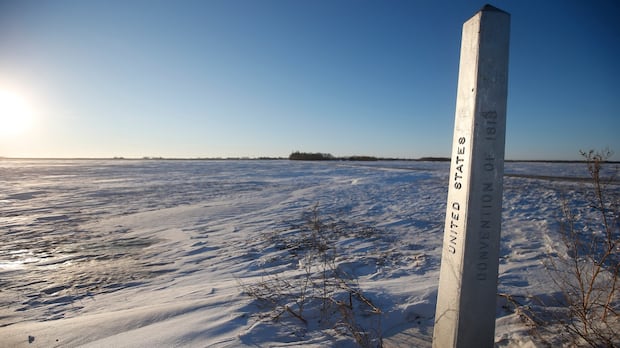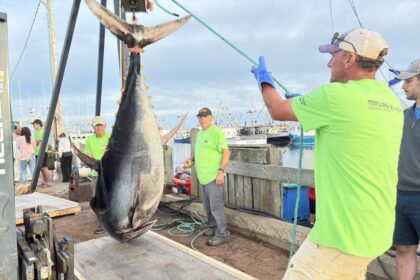Manitoba·UpdatedWhile the number of illegal crossings at the North Dakota and Minnesota border with Canada is dropping, U.S. authorities still fear human trafficking will lead to more deaths during the dangerous winter months. Crossings from Canada into North Dakota, Minnesota down 60% from last year: U.S. Border PatrolListen to this articleEstimated 5 minutesU.S. Customs and Border Protection is warning of the dangers migrants face if they try crossing illegally from Canada into the United States during the winter months. (John Woods/The Canadian Press)While the number of illegal crossings at the North Dakota and Minnesota border with Canada is dropping, U.S. authorities still fear human trafficking will lead to more deaths during the dangerous winter months.”Human smugglers … only value their self-profit, with total disregard for human life,” said Scott Garrett, the chief patrol agent for the Grand Forks Sector — the U.S. Customs and Border Protection division responsible for overseeing nearly 1,400 kilometres of the international border shared between North Dakota and Minnesota in the U.S., and the Canadian provinces of Saskatchewan, Manitoba and Ontario.”The reality is that illegal aliens have and will continue to lose their lives while crossing the border, despite our consistent warnings.”During a news conference on Tuesday in Warroad, Minn., Customs and Border Protection displayed some of the equipment the Grand Forks division uses to patrol the area, as part of the agency’s efforts to raise awareness about the deadly risks migrants face when making illegal crossings.”They underestimate how cold it can truly get,” said Garrett. “They cross the border unprepared, having inadequate clothing, not understanding how quickly the onset of frostbite or hypothermia will set in.”Scott Garrett, chief patrol agent for U.S. Customs and Border Protection’s Grand Forks Sector, says while illegal border crossings from Canada into North Dakota and Minnesota have declined, officials fear migrants will continue trying to make dangerous crossings during the winter. (Catherine Moreau/Radio-Canada)Illegal crossings from Canada into the U.S. have dropped by about 60 per cent from last year, said Garrett — a decline he attributed to the efforts of U.S. President Donald Trump’s administration to enforce immigration laws.RCMP and the Canada Border Service Agency have also stepped up patrols — contributions that have heavily impacted illegal cross-border traffic dropping in both directions, Garrett said. Manitoba Conservation officers began patrols along the U.S. border focused on secondary roads and backcountry areas between ports of entry at the crossing last winter.A provincial spokesperson told CBC Conservation officers continue patrolling the border as part of their duties, working with other agencies.A Canada Border Service Agency spokesperson said it welcomes the collaboration of all partners in intercepting people crossing the border illegally, but the agency deferred to the RCMP for further comment. CBC has reached out to the Mounties.U.S. border agents in North Dakota and Minnesota have been outfitted with “a lot more” resources, said Garrett, such as infrared surveillance cameras, ATVs and snowmobiles, as well as technology enhancements to their fleet of vehicles and drones that have increased their effectiveness in locating people after they cross the border. “For us, it doesn’t just mean people coming into the U.S., it also means people headed in the other direction,” he said. According to Garrett, illegal traffic from the U.S. into Canada in the Grand Forks Sector has dropped by roughly 20 per cent since last year. “We want to clear up the border for those that cross the border legally and safely,” he said. ‘1 death is too many’Citizens from Mexico, India and Romania make up the three largest groups of those crossing illegally into the United States in the Grand Forks Sector, Garrett said. Those demographic groups haven’t changed, nor has the presence of children among those apprehended, he said.Around a month ago, border authorities found a family that had crossed with one-year-old twin siblings, said Garrett.”Over the past few years, we’ve become pretty, pretty well adapted to treating family units, to make sure we have on hand diapers, baby formula … but it’s not what we’re trained for,” he said. In one of the most high-profile cases at the border in recent years, a family of four from India — Jagdish Patel, 39, his 37-year-old wife, Vaishali, their 11-year-old daughter, Vihangi, and their three-year-old son, Dharmik — were found frozen to death in January 2022 in Manitoba, just 12 metres from the U.S. border, after they got separated from the larger group of migrants they were with. Two men were found guilty by a U.S. jury in November 2024 of charges related to bringing unauthorized people into the country, transporting them and profiting from it in connection with their deaths.Earlier this year, another man accused by police in India of being involved in that human smuggling operation was taken into custody. Garrett said in most cases, people cross from Canada on their own, following directions telling them where to meet a car that’s supposed to pick them in the U.S. But Garrett said border patrol agents often catch the smugglers “before they get to … take their cargo, their human contraband,” he said. “People work out of Minneapolis, some out of Chicago — that’s their main area.”A daytime infrared camera mounted on the bed of a pickup truck is one of the devices used by U.S. Customs and Border Protection to patrol North Dakota and Minnesota. (Tyson Koschik/CBC)But the long stretches of rural countryside between official border entry points — and frozen rivers used by smugglers during the winter months — present challenges for border patrol agents, said Garrett.”We still have work to do, as long as human smuggling exists. The border patrol’s mission continues to prioritize the protection of our nation’s security,” he said.But the danger to human safety during the winter season cannot be overstated, said Garrett.”One death is too many.”WATCH | U.S. border officials warn against dangerous illegal crossings in winter:U.S. border officials warn against dangerous illegal crossings in winterThe number of illegal crossings at the North Dakota and Minnesota borders with Canada is dropping, but officials say they expect human trafficking to continue despite dangerous winter conditions.ABOUT THE AUTHORSantiago Arias Orozco is a journalist with CBC Manitoba currently based in Winnipeg. He previously worked for CBC Toronto and the Toronto Star. You can reach him at santiago.arias.orozco@cbc.ca.With files from Cameron MacIntosh and Radio-Canada
Monday, 22 Dec 2025
Canada – The Illusion
Search
Have an existing account?
Sign In
© 2022 Foxiz News Network. Ruby Design Company. All Rights Reserved.
You May also Like
- More News:
- history
- Standing Bear Network
- John Gonzalez
- ᐊᔭᐦᑊ ayahp — It happened
- Creation
- Beneath the Water
- Olympic gold medal
- Jim Thorpe
- type O blood
- the bringer of life
- Raven
- Wás’agi
- NoiseCat
- 'Sugarcane'
- The rivers still sing
- ᑲᓂᐸᐏᐟ ᒪᐢᑿ
- ᐅᑳᐤ okâw — We remember
- ᐊᓂᓈᐯᐃᐧᐣ aninâpêwin — Truth
- This is what it means to be human.
- Nokoma











